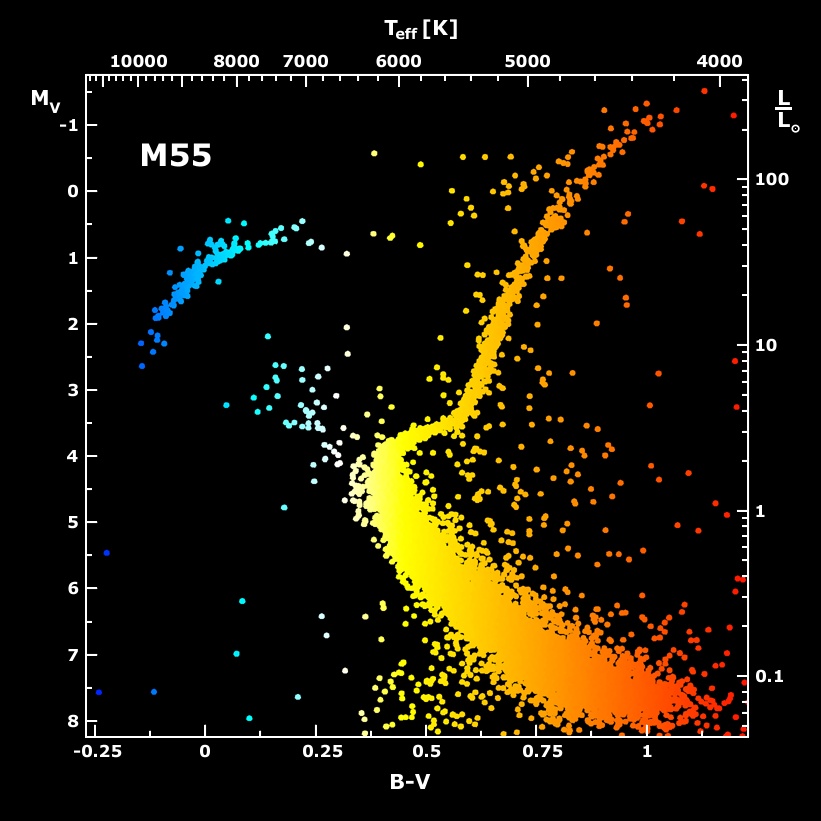Page 2 of 4
Re: APOD: Globular Cluster M15 from Hubble (2013 Nov 19)
Posted: Tue Nov 19, 2013 4:32 pm
by Errol Genet
Just for fun, I magnified the hires image of the cluster about 200%. Looking at about 7-8 O'Clock right next to the center of the cluster, I noticed red color apparently bridging between stars. Am I right to believe that this is a result of imaging artifact?
Re: APOD: Globular Cluster M15 from Hubble (2013 Nov 19)
Posted: Tue Nov 19, 2013 4:52 pm
by geckzilla
geckzilla wrote:Chris Peterson wrote:Maybe trying to get the system to support hover images with attachments that don't need to be elsewhere in the post, as well? That's an annoyance.
Yeah, I think I can do something about that.
I couldn't figure out a way to isolate the two images within inline attachments in posts. I think it would be possible with multiple sets of BBCode but that's even worse than the way it currently works. I did create a new tag for hiding text, images, or whatever is inside that will display only three dots in place. It's not any less annoying when composing your post but at least this way you won't have to clutter your post with the spoiler tag. The hide tag might also be useful for other purposes.
Re: APOD: Globular Cluster M15 from Hubble (2013 Nov 19)
Posted: Tue Nov 19, 2013 4:53 pm
by Ann
Markus Schwarz wrote:Why are the diffraction spikes of the red stars different in size than the ones from the blue stars? Are there separate cameras mounted differently, or is it due to the different wavelengths?
B.J. Mochejska, J. Kaluzny (CAMK), 1 m Swope Telescope
The brightest stars in globular clusters are always the red giants. Take a look at this color-magnitude diagram of globular cluster M55. As you can see, the brightest stars are also the reddest stars. (And the faintest stars are also the reddest stars!) In any case, the brightest stars will have the largest diffraction spikes.
Today's APOD is very interesting in that we can clearly see the difference between different kinds of blue horizontal stars. The blue horizontal stars are highly evolved but not terribly massive stars with hot cores. They have "evolved back" from red gianthood, and they have shrunk as they did so. Because the stars in very old globular clusters are so metal-poor, they are very transparent and therefore bluer for the same mass than stars like the Sun.
As for the blue horizontal branch stars, the smallest of them are the bluest. Correspondingly, the brightest red giants are the largest.
We can clearly see the difference between the very blue horizontal branch stars and those that are merely aqua-colored or cyan. The filters used for this image, according to
http://www.spacetelescope.org/images/heic1321a/, were
Ultraviolet 275 nm,
Ultraviolet 336 nm,
Optical 438 nm,
Optical 606 nm, and
Infrared 814 nm. This means that the bluest-looking stars are strongly ultraviolet, and the cyan-colored stars are really quite blue, but not so ultraviolet. The reddest stars are very infrared.
The reason why the planetary nebula looks so blue is that it is very bright in ultraviolet light, which is clearly detected by the two ultraviolet filters used for this image. But neither the Ha line at 656 nm, nor the OIII line at 501 nm, nor the Hβ line at 486 nm, were clearly detected by any of the filters here.
It is interesting to look at the profusion of small white-looking stars in M15. What kind of stars are they? I would hazard a guess that they are similar in mass to the Sun, but bluer in color.
Note, too, that we can see huge numbers of small red and orange stars. The brightest of them are certainly K-type stars, although if they had been more metal-rich they might have been classified as M-type stars. Others are so red and faint that it is hard to believe that they are not tiny little red dwarfs, twelve billion years old. Occasional little blue dots are also visible, which may be white dwarfs.
What an interesting APOD!
Ann
Re: APOD: Globular Cluster M15 from Hubble (2013 Nov 19)
Posted: Tue Nov 19, 2013 4:59 pm
by geckzilla
Errol Genet wrote:Just for fun, I magnified the hires image of the cluster about 200%. Looking at about 7-8 O'Clock right next to the center of the cluster, I noticed red color apparently bridging between stars. Am I right to believe that this is a result of imaging artifact?
Probably just diffraction spikes. I don't see anything else in that area.
Re: APOD: Globular Cluster M15 from Hubble (2013 Nov 19)
Posted: Tue Nov 19, 2013 5:00 pm
by Guest
What would the night sky look like from a planet orbiting one of the center stars?
Re: APOD: Globular Cluster M15 from Hubble (2013 Nov 19)
Posted: Tue Nov 19, 2013 5:11 pm
by tomatoherd
Chris:
thanks.
Time will tell.
Yet if gravity has been figured out, the physicists have done a remarkably poor job of transferring that knowledge to the public (the interested, educated public).
Maybe it slipped in some nanosecond between NFL stories...
Re: APOD: Globular Cluster M15 from Hubble (2013 Nov 19)
Posted: Tue Nov 19, 2013 6:15 pm
by neufer
Markus Schwarz wrote:
Why are the diffraction spikes of the red stars different in size than the ones from the blue stars?
Are there separate cameras mounted differently, or is it due to the different wavelengths?
Mostly due to the different wavelengths.
Re: APOD: Globular Cluster M15 from Hubble (2013 Nov 19)
Posted: Tue Nov 19, 2013 6:21 pm
by geckzilla
tomatoherd wrote:Chris:
thanks.
Time will tell.
Yet if gravity has been figured out, the physicists have done a remarkably poor job of transferring that knowledge to the public (the interested, educated public).
Maybe it slipped in some nanosecond between NFL stories...
I'd consider myself interested and educated but I don't expect to understand the deeper realms of physics without some serious dedication. There are some things that can't be explained in simplified terms. Or, rather, the most simplified explanation is just not something one can spend a few hours reading about and expect to have any more than a vague understanding and it's certainly not something you can cram into an hour long TV show or anything like that. What did you want, a Matrix plug in the base of your cranium you can hook some electronics up to and upload the information to you? "I know quantum fu."
Re: APOD: Globular Cluster M15 from Hubble (2013 Nov 19)
Posted: Tue Nov 19, 2013 6:32 pm
by Errol Genet
geckzilla wrote:Errol Genet wrote:Just for fun, I magnified the hires image of the cluster about 200%. Looking at about 7-8 O'Clock right next to the center of the cluster, I noticed red color apparently bridging between stars. Am I right to believe that this is a result of imaging artifact?
Probably just diffraction spikes. I don't see anything else in that area.
That must be it. Looked odd. Thanks.
Re: APOD: Globular Cluster M15 from Hubble (2013 Nov 19)
Posted: Tue Nov 19, 2013 7:17 pm
by dwainwilder
Chris Peterson wrote:
Globular clusters do have a net angular momentum. They do demonstrate global rotation. There is evidence in some of differential rotation. I'm not sure what you mean by "behave like a galaxy"...
Thank you, Chris. Very interesting. By "behave like a galaxy" I meant such phenomena of differential rotation as arm formations, perhaps star forming regions (due to tidal forces?) and noticeable interaction with nearby features of the galaxy.
Re: APOD: Globular Cluster M15 from Hubble (2013 Nov 19)
Posted: Tue Nov 19, 2013 7:22 pm
by tomatoherd
geckzilla wrote:tomatoherd wrote:Chris:
thanks.
Time will tell.
Yet if gravity has been figured out, the physicists have done a remarkably poor job of transferring that knowledge to the public (the interested, educated public).
Maybe it slipped in some nanosecond between NFL stories...
I'd consider myself interested and educated but I don't expect to understand the deeper realms of physics without some serious dedication. There are some things that can't be explained in simplified terms. Or, rather, the most simplified explanation is just not something one can spend a few hours reading about and expect to have any more than a vague understanding and it's certainly not something you can cram into an hour long TV show or anything like that. What did you want, a Matrix plug in the base of your cranium you can hook some electronics up to and upload the information to you? "I know quantum fu."
Funny how the public (interested, educated fraction) grasped Newtonian physics, and since then relativity (even did those equations in undergrad) and is appreciating quantum concepts more and more, and yet gravity is only for the select few to understand? what's is it, a gnostic religion?
Actually, maybe they can beam it into my brain in dark energy quanta via my Ouija board.
Re: APOD: Globular Cluster M15 from Hubble (2013 Nov 19)
Posted: Tue Nov 19, 2013 7:30 pm
by neufer
geckzilla wrote:
I'd consider myself interested and educated but I don't expect to understand the deeper realms of physics without some serious dedication. There are some things that can't be explained in simplified terms. Or, rather, the most simplified explanation is just not something one can spend a few hours reading about and expect to have any more than a vague understanding and it's certainly not something you can cram into an hour long TV show or anything like that.
http://groupprops.subwiki.org/wiki/Semisimple_group wrote:
<<
A group is said to be semisimple if it occurs as a central product of quasisimple groups. Every finite group can be realized as a subgroup of a semisimple group. This follows from the fact that every finite group can be realized as a subgroup of a simple non-Abelian group. Every quotient of a semisimple group is semisimple. This follows from the fact that every quotient of a quasisimple group is quasisimple, and that a central product is preserved on going to the quotient.>>
Re: APOD: Globular Cluster M15 from Hubble (2013 Nov 19)
Posted: Tue Nov 19, 2013 7:50 pm
by tomatoherd
Thank you, Art (and Albert)! My thoughts exactly.
Re: APOD: Globular Cluster M15 from Hubble (2013 Nov 19)
Posted: Tue Nov 19, 2013 7:58 pm
by geckzilla
tomatoherd wrote:Thank you, Art (and Albert)! My thoughts exactly.
Don't thank Albert. He never actually said that. It's just another quote attributed to him in order to try to make it look like it has some deep, authoritative meaning behind it.
http://en.wikiquote.org/wiki/Albert_Ein ... attributed
You do not really understand something unless you can explain it to your grandmother.
variant: If you can't explain something to a six-year-old, you really don't understand it yourself.
variant: If you can't explain it simply, you don't understand it well enough.
Frequently attributed to Richard Feynman
Probably based on a similar quote about explaining physics to a "barmaid" by Ernest Rutherford
Page 418 of Einstein: His Life and Times (1972) by Ronald W. Clark says that Louis de Broglie did attribute a similar statement to Einstein:
To de Broglie, Einstein revealed an instinctive reason for his inability to accept the purely statistical interpretation of wave mechanics. It was a reason which linked him with Rutherford, who used to state that "it should be possible to explain the laws of physics to a barmaid." Einstein, having a final discussion with de Broglie on the platform of the Gare du Nord in Paris, whence they had traveled from Brussels to attend the Fresnel centenary celebrations, said "that all physical theories, their mathematical expressions apart ought to lend themselves to so simple a description 'that even a child could understand them.' "
The de Broglie quote is from his 1962 book New Perspectives in Physics, p. 184.
Cf. this quote from David Hilbert's talk Mathematical Problems given in 1900 before the International Congress of Mathematicians:
"A mathematical theory is not to be considered complete until you have made it so clear that you can explain it to the first man whom you meet on the street."
I don't suppose we have any complete mathematical theories if any of these quotes are to be taken seriously.
Re: APOD: Globular Cluster M15 from Hubble (2013 Nov 19)
Posted: Tue Nov 19, 2013 9:07 pm
by neufer
Re: APOD: Globular Cluster M15 from Hubble (2013 Nov 19)
Posted: Tue Nov 19, 2013 9:22 pm
by Guest
Guest wrote:What would the night sky look like from a planet orbiting one of the center stars?
I was coming here to ask the same question....
Re: APOD: Globular Cluster M15 from Hubble (2013 Nov 19)
Posted: Tue Nov 19, 2013 9:45 pm
by Anthony Barreiro
Guest wrote:Guest wrote:What would the night sky look like from a planet orbiting one of the center stars?
I was coming here to ask the same question....
http://en.wikipedia.org/wiki/Globular_cluster#Composition wrote:Globular clusters are generally composed of hundreds of thousands of low-metal, old stars. The type of stars found in a globular cluster are similar to those in the bulge of a spiral galaxy but confined to a volume of only a few million cubic parsecs. They are free of gas and dust and it is presumed that all of the gas and dust was long ago turned into stars.
Globular clusters can contain a high density of stars; on average about 0.4 stars per cubic parsec, increasing to 100 or 1000 stars per cubic parsec in the core of the cluster. The typical distance between stars in a globular cluster is about 1 light year, but at its core, the separation is comparable to the size of the Solar System (100 to 1000 times closer than stars near the Solar System).
However, they are not thought to be favorable locations for the survival of planetary systems. Planetary orbits are dynamically unstable within the cores of dense clusters because of the perturbations of passing stars. A planet orbiting at 1 astronomical unit around a star that is within the core of a dense cluster such as 47 Tucanae would only survive on the order of 108 years. There is a planetary system orbiting a pulsar (PSR B1620−26) that belongs to the globular cluster M4, but these planets likely formed after the event that created the pulsar.
Re: APOD: Globular Cluster M15 from Hubble (2013 Nov 19)
Posted: Tue Nov 19, 2013 9:47 pm
by neufer
Guest wrote:Guest wrote:
What would the night sky look like from a planet orbiting one of the center stars?
I was coming here to ask the same question....
There would be dozens of stars brighter than the brightest historical supernova
and perhaps a thousand stars brighter than Venus.
Re: APOD: Globular Cluster M15 from Hubble (2013 Nov 19)
Posted: Tue Nov 19, 2013 11:51 pm
by Chris Peterson
tomatoherd wrote:Funny how the public (interested, educated fraction) grasped Newtonian physics, and since then relativity (even did those equations in undergrad) and is appreciating quantum concepts more and more, and yet gravity is only for the select few to understand? what's is it, a gnostic religion?
Gravity as described by general relativity is not hard to understand. It is hard to actually manipulate the equations, but not to understand the broad principles.
Personally, I've never encountered any subject so complex that a fundamental understanding can't be conveyed in a few paragraphs or less, assuming an interested learner.
Re: APOD: Globular Cluster M15 from Hubble (2013 Nov 19)
Posted: Wed Nov 20, 2013 2:05 am
by Coil_Smoke
One day everyone will know that "gravity" only appears to be an attractive force.
Re: APOD: Globular Cluster M15 from Hubble (2013 Nov 19)
Posted: Wed Nov 20, 2013 2:21 am
by rstevenson
Coil_Smoke wrote:One day everyone will know that "gravity" only appears to be an attractive force.
And you will reveal the details of this when?
Rob
Re: APOD: Globular Cluster M15 from Hubble (2013 Nov 19)
Posted: Wed Nov 20, 2013 2:42 am
by Nitpicker
rstevenson wrote:Coil_Smoke wrote:One day everyone will know that "gravity" only appears to be an attractive force.
And you will reveal the details of this when?
Rob
Well, to be fair, Coil_Smoke did say: "one day". And on that day, I expect I'll "fall" off the "planet". I find the whole thing very unattractive.
Re: APOD: Globular Cluster M15 from Hubble (2013 Nov 19)
Posted: Wed Nov 20, 2013 2:44 am
by Coil_Smoke
Well...Think of it as having the weight of the universe on your shoulders. Replace the notion of gravitational attraction with a universal tropism that likes to push things around. Things move from an area of high "gravitational" density towards areas of lower density. This density is greatest in deep space and lowest at the surface of a body. All "matter" in the universe gives rise to this force. We are forced towards the center of the Earth because it blocks the propagation of this force beneath our feet....C_S
Re: APOD: Globular Cluster M15 from Hubble (2013 Nov 19)
Posted: Wed Nov 20, 2013 2:51 am
by owlice
:moderator hat on:
Coil_Smoke, before you go any further, please read the rules, and please pay particular attention to rule 15. Thanks.
:moderator hat off:
Re: APOD: Globular Cluster M15 from Hubble (2013 Nov 19)
Posted: Wed Nov 20, 2013 2:57 am
by Coil_Smoke
OK, I do remember reading that some years back.



